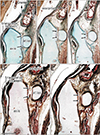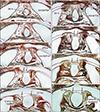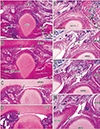Abstract
Figures and Tables
 | Fig. 1Sagittal sections of the median atlanto-axial joint from two mid-term specimens. Panels A–C display a specimen of 82 mm crown-rump length (CRL), while panels D and E show a specimen of 100 mm CRL. Panel A (D) is the most medial side of the figure, whereas panel C (E) is the most lateral side. (A–C) A disk-like structure (arrows) is thick in lateral part of the joint cavity (C) and thin in the medial part (A). Likewise, in panels D and E, the structure appears to be complete at the medial part (D). Arrows in D and E indicate a disk-like structure. All panels were prepared at the same magnification. Scale bar=1 mm (D). |
 | Fig. 2Horizontal sections of the median atlanto-axialjoint from two mid-term specimens. Panels A–E display a specimen of 96 mm crown-rump length (CRL), while panels F–I show a specimen of 100 mm CRL. Panel A is the most superior side of the figure, whereas panel E is the most inferior side. In the former specimen, a disk-like structure (D, E; arrows) is continuous with mesenchymal tissue at the irregular superior margin of the joint cavity (A, B). In the latter specimen, the roof of the joint cavity is separated from the atlas between panels F and G. In both specimens, the structure was not a complete septum but was considered to be a superior marginal fold (E, I). Arrows in G, H, and I indicate a disk-like structure. All panels were prepared at the same magnification. Scale bar=1 mm (A). |
 | Fig. 3Sagittal sections of short flexed fold in the median atlanto-axial joint from a late-stage specimen. Panels A–F display a specimen of 270 mm crown-rump length. Panel A is the most lateral side of the figure, Panel C is the most medial side. The right-hand side of the figure corresponds to the anterior side of the head. Panels A–C show lower-magnification views to illustrate the topographical anatomy. Panels D–F show higher-magnification views of the anterior component of the joint. A short fold (arrows) is attached to the superior margin of the joint cavity at the medial or nearly median site (F). Scale bars=1 mm (A, D). |
 | Fig. 4Sagittal sections of thin but large disk-like structure in the median atlanto-axial joint from a late-stage specimen. Panels A–F display a specimen of 280 mm crown-rump length. Panel A is the most lateral side of the figure, panel C is the most medial side. The right-hand side of the figure corresponds to the anterior side of the head. Panels A–C show lower-magnification views to illustrate the topographical anatomy. Asterisk indicates the posterior atlanto-occipital membrane that has become separated from the vertebrae during histological procedures. Note the relatively low position of the upper tip of the dens relative to the anterior atlantal arch. Panels D–F show higher-magnification views of the anterior component of the median atlanto-axial joint. Arrows in D and E indicate a short membranous structure. A short membranous structure (arrows) is interrupted in the medial or nearly median aspect (F). Scale bars=1 mm (A, D). |
 | Fig. 5Horizontal and sagittal sections of two late-stage specimens. The sectional plane of panels A–D was horizontal, while that of panels E–H was sagittal. Panels A–E display a specimen of 270 mm crown-rump length (CRL), while panels F–H show a specimen of 280 mm CRL. In the former specimen, panel A is the most superior side of the figure, whereas panel D is the most inferior side. The upper side of the figure corresponds to the anterior side of the head. In the latter specimen, panel E is the most lateral side of the figure, whereas panel H is the most medial side. A membranous structure (arrows) is a short, thin synovial fold projecting from the roof of the joint cavity in association wi th ti ssue fragments scattered within the cavity (A–D). Arrow in E indicates a membranous structure. The membranous structure (arrows) is interrupted in the medial or nearly median aspect (F–H). All panels were prepared at the same magnification. Scale bars=5 mm (A, E). |




 PDF
PDF ePub
ePub Citation
Citation Print
Print



 XML Download
XML Download